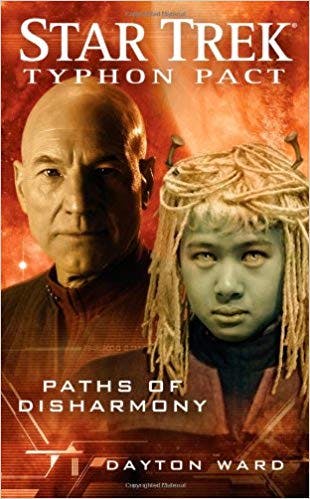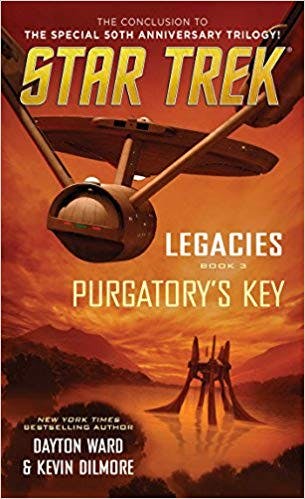Published Nov 10, 2021
Trekking Through National Novel Writing Month
Prolific Star Trek author, Dayton Ward, has some tips for using #NaNoWriMo to your advantage — for Trek writing and not, alike!

StarTrek.com
For many a writer, November is a month of special significance. It’s when we’re invited to cast aside pretty much everything else in our lives for thirty days in service of pursuing a single goal: WRITE.Specifically, we’re challenged to write 50,000 words during that period, which for nearly two decades has been known has National Novel Writing Month. Writers at all stages of their careers from seasoned professionals to hopeful new voices have used the program to provide themselves with a bit of “public accountability” as they labor to meet audacious word count goal. To put things in perspective, 50,000 words is on the low end of what constitutes a novel these days and is approximately half of what I’m typically expected to deliver when I write a Star Trek novel. Still, even published authors use NaNoWriMo to motivate themselves with the goal of writing at least a portion of their longer work-in-progress.This time of year, I’m often asked if I’ve ever used NaNoWriMo as a catalyst for writing any of my Star Trek novels. Indeed I have, and in all honesty, my results have been mixed. In theory, one could reasonably presume something like NaNoWriMo lends itself to the realm of tie-in writing, given this particular niche of publishing’s peculiar and demanding nature. Deadlines are often tight—far more aggressive than one might normally expect when compared to writing original fiction or other books not based on a licensed property. That was my thinking the first time I attempted to crank 50,000 words toward a Star Trek novel I wrote back in 2009, Paths of Disharmony. While I had an active writing November that year, I fell well short of the 50k goal on this project. Part of the problem was my also working on other writing assignments in various states of gestation while juggling a full-time job as a software developer. My takeaway? Plan better and write smarter.

StarTrek.com
Fate and scheduling saw to it that I was not faced with writing a novel during the month of November again until 2014, by which time I was collaborating with my friend and frequent writing partner, Kevin Dilmore, on All That’s Left, the fourth entry in Pocket Books’ Star Trek: Seekers novel series we created with fellow author David Mack. Having learned a few harsh lessons during my previous dance with NaNoWriMo, I was able to generate a significant portion of my contribution to that effort during the 30-day window. I enjoyed similar success the following November, by which time I was once again partnering with Kevin to write Purgatory’s Key, our contribution to Pocket’s 2016 Star Trek: Legacies trilogy celebrating Star Trek: The Original Series’ 50th anniversary. While we worked with fellow writers David Mack and Greg Cox on this project, Kevin and I were still tasked with delivering our own novel, and November 2015 proved to be a productive month for me with this book.I conducted an informal survey about this topic on my Facebook page a short while back while preparing to write this article. I asked my friends and followers, be they fellow Star Trek novelists or fans who write their own Star Trek fanfiction for fun, if they’d ever participated in NaNoWriMo for such a project. The responses were varied, but a few people had indeed used the November challenge to write a “bit of the Trek.”

StarTrek.com
On a few occasions over the years, I’ve written pieces for my blog and other venues where I attempt to offer advice to those attempting NaNoWriMo for the first time. Every writer’s mileage varies when it comes to their individual process and finding time to write in and around other commitments, so I’ve always tried to keep my advice general enough so it can be applied no matter the specific situation. Want a couple of easy tips for surviving NaNoWriMo? Here we go:
Manage your pace. You’ve got so many days and so many words to write. Don’t over think this. Figure out a words-per-day rate and aim for that number. Take this in portions rather than focusing on the 50k mark. It’ll start adding up pretty quickly. 50,000 divided by 30 days is 1,667 words a day. That might sound like a lot, but breaking it into smaller chunks and spreading them throughout the day can ease the stress a bit. Figure out a breakdown that works for your schedule and go from there.
Don’t kill yourself. Remember: Marathon, not sprint. Quit writing for the day if you hit your quota. If, on the other hand, you’re in the zone and write way beyond your daily goal, give yourself a break the next day. If you miss a day, then work a bit harder over a few days to get back on pace, rather than trying to gain it all back in one sitting. Or, just recalculate a new per-day rate to absorb the words from the missed day. You’re looking to attack this without inflicting undue stress on yourself. Portions. Pace. Consistency. Repeat.
Write now. Edit later. Your goal is to keep pushing forward, every day, all the way to the finish line and you can’t do that if you keep going back over what you’ve already written. We all have an inner editor, wanting us to revise the paragraph or page we just finished, or who keeps telling us the chapter we wrote yesterday needs a rewrite. Ignore those impulses. This exercise isn’t about having a perfect, polished, ready to rock manuscript on November 30th. All of that comes afterward.
Okay, so the month flies by as you’ve labored on your novel. What happens when the calendar moves to December? The first thing you should do is congratulate yourself on a job well done. Writing isn’t easy to begin with, but accomplishing 50,000 words in a month while juggling the rest of the people and demands in your life is to be celebrated. You’ve earned it. Even if you fell short of the mark, you’ve likely picked up some habits and structure from attempting to write within the NaNoWriMo framework which can serve you in your future writing. After giving yourself a well-deserved break, take a hard look at what you wrote in November, and either keep adding to it as appropriate or start the editing and revision process. Finish what you started, then remember what you’ve learned during the experience and take it with you when you start your next project.Because some of my informal survey respondents mentioned writing Star Trek stories during NaNoWriMo, this naturally prompts the question of what happens to these tales once they’re finished. For me, working under a contract from Simon & Schuster, it meant my scribblings eventually ended up in a published Star Trek novel. I’m often asked how fans might hope to see their own tales given similar treatment. Unfortunately, professionally publishing a Star Trek novel—or a novel based on any other existing media property like Star Wars, to name just one prominent example—isn’t the sort of opportunity that comes along easily.
Most of the writers who do this kind of work have been writing professionally for quite some time. Editors of tie-in novels often work on tight schedules while overseeing multiple books within a given series, and they tend to rely on writers with whom they have a solid working relationship and who they know will deliver clean manuscripts on time. If your dream is to someday write and publish a professional Star Trek novel, your best chance for success is to sell some of your original fiction first. Establishing some publishing credentials and experience as well as a reputation for solid work will make you much more attractive to an editor looking to add a new voice to their tie-in line. Meanwhile, don’t let this deter you from taking the NaNoWriMo challenge. The experience you’ll acquire will benefit you later if your aim is to write a media tie-in novel. The daily word rate needed to achieve your NaNoWriMo goal is actually not much different than the pace I usually keep to stay on schedule for my own Star Trek novel work. Figuring out how to on task every day regardless of other commitments, demands, or distractions just during that one month is a great learning aid, as well as a valuable, peek into the real world of a working writer. Embrace the opportunity and all it can teach you. For those of you participating in National Novel Writing Month, I wish you the best of luck!
Dayton Ward (he/him) is a New York Times bestselling author or co-author of numerous novels and short stories, including a whole bunch of stuff set in the Star Trek universe, and often working with friend and co-writer Kevin Dilmore. As he’s still a big ol' geek at heart, Dayton is known to wax nostalgic about all manner of Star Trek topics over on his own blog, The Fog of Ward.

